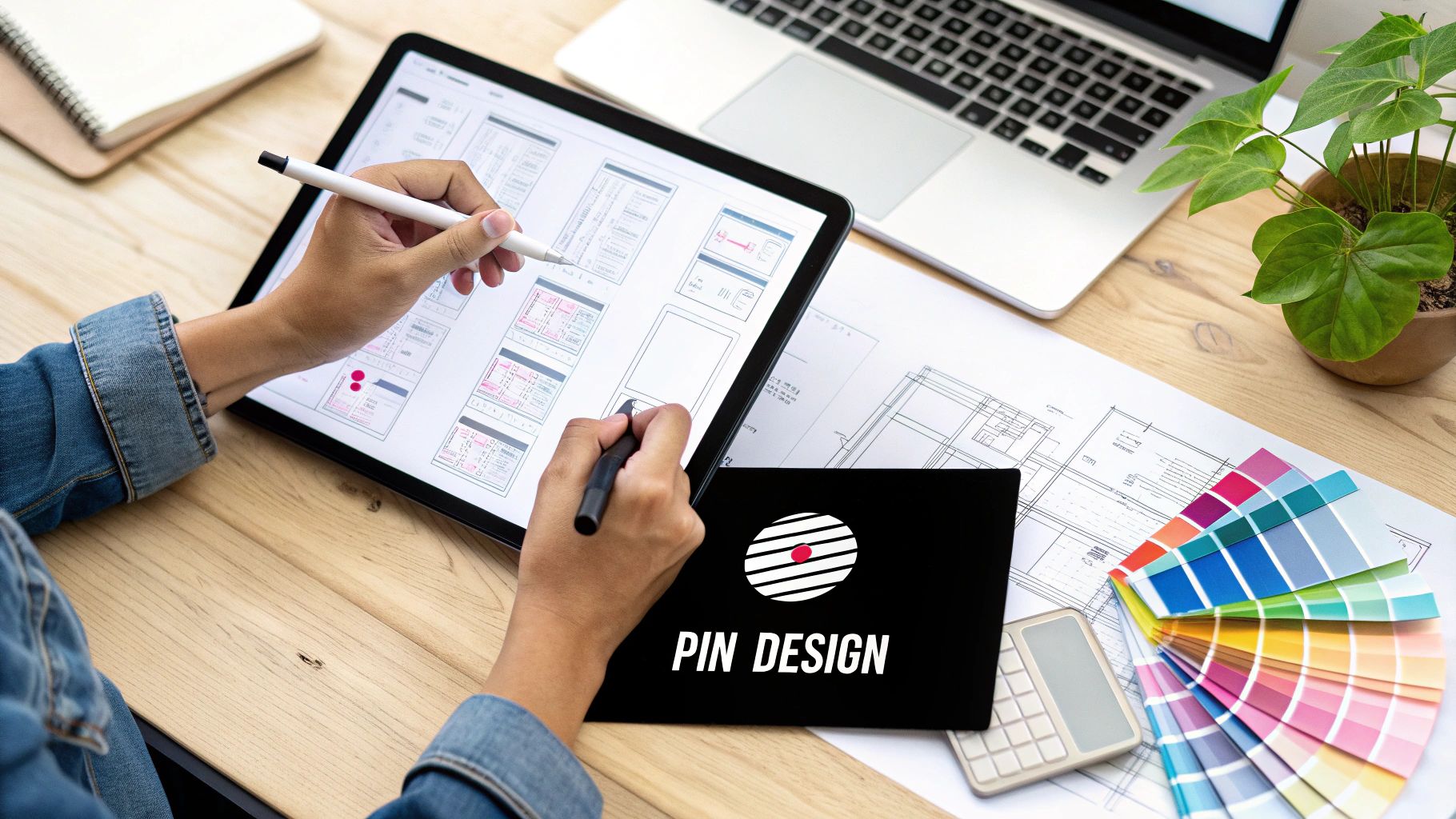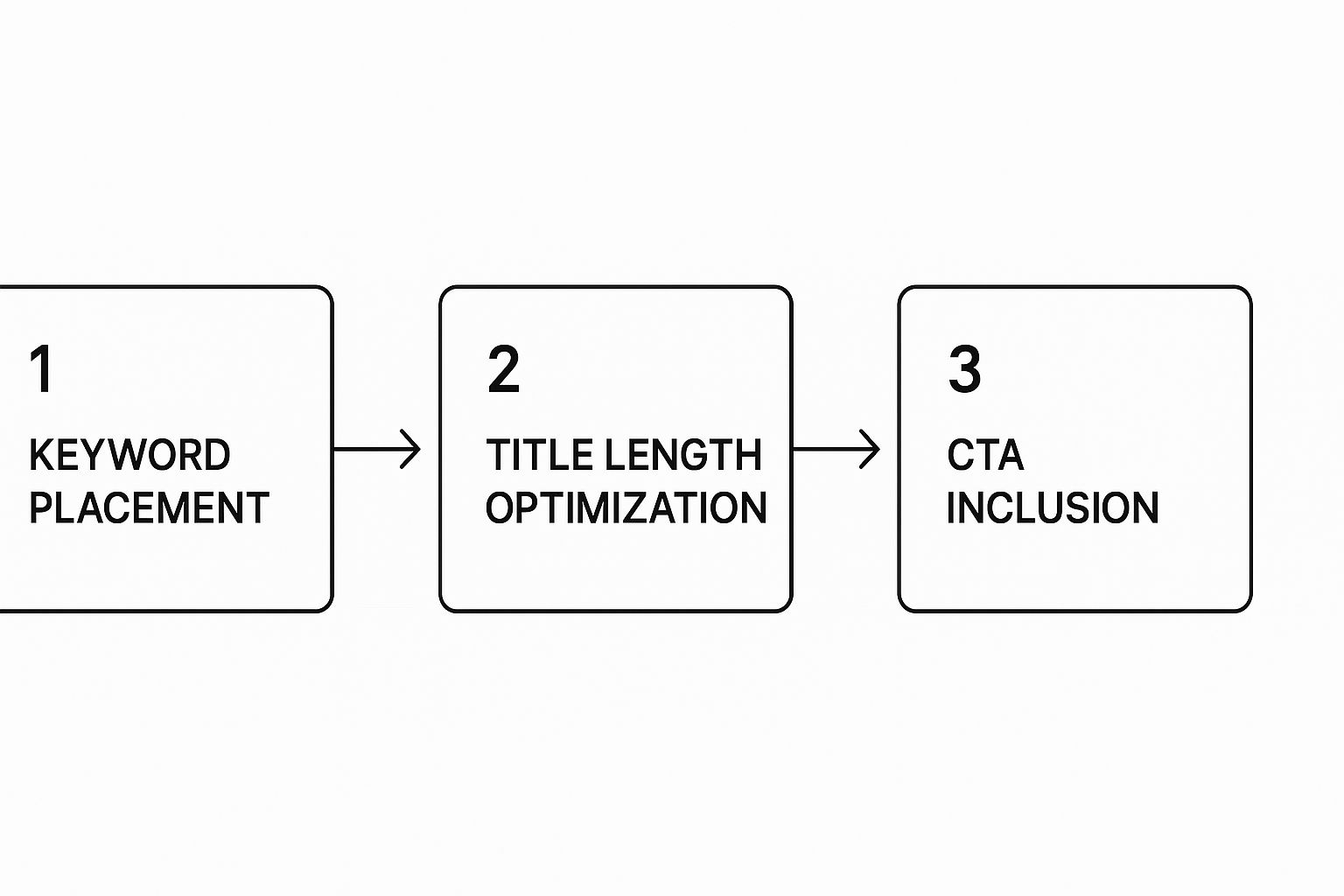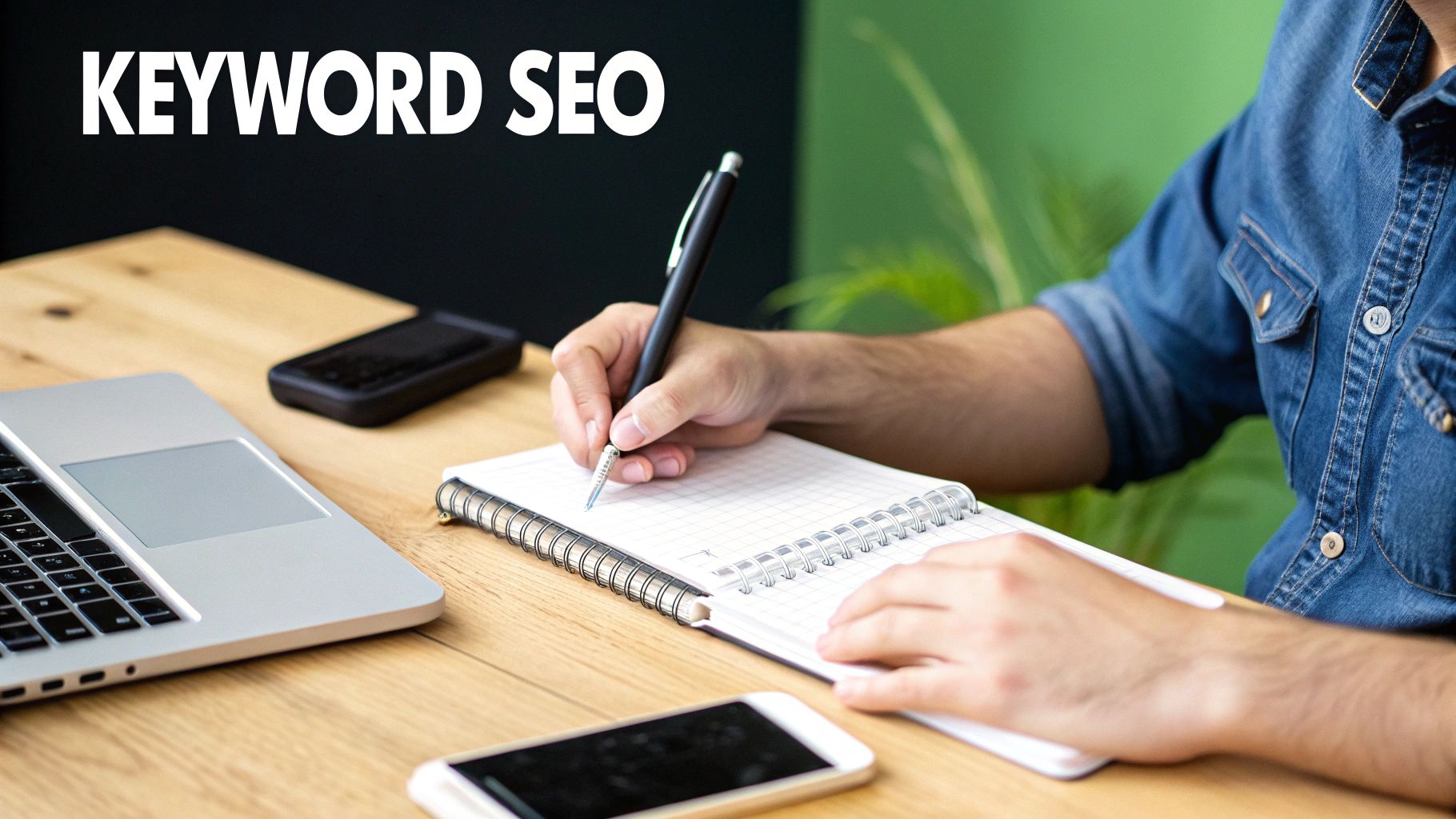Your Guide to Creating Pins for Pinterest That Convert
Creating a pin isn't just about throwing an image up on Pinterest. It's really about crafting a visually compelling asset that stops the scroll. A great pin needs a clear text overlay and a strong call-to-action that actually gets people to click.
When done right, a pin grabs attention, shows its value in a split second, and gives users a reason to visit your website.
Why High-Impact Pins Are Your Secret Weapon on Pinterest

It’s tempting to lump Pinterest in with all the other social media sites, but that's a huge mistake. Think about it: a tweet or an Instagram story is gone in a flash. A pin, on the other hand, has an incredibly long lifespan. It's a visual search engine where people are actively looking for solutions, inspiration, and things to buy.
This means the user mindset is completely different. People don't just mindlessly scroll; they come to Pinterest with a purpose. They're planning a future purchase, searching for a recipe for dinner tonight, or finding decor ideas for a home renovation. This active, forward-looking intent makes them incredibly receptive to your content—if you present it well.
The Lasting Power of a Pin
Consider the content you see on other platforms. Its shelf life is usually measured in hours. A pin, however, gets saved to boards, pops up in searches, and gets re-pinned by others, extending its reach far beyond your initial followers. It's this compounding effect that makes Pinterest a uniquely powerful strategy for long-term growth.
The numbers don't lie. With over 570 million monthly active users and growing 10% year-over-year, the platform’s reach is massive. Users save an average of 1.5 billion pins every single week, which shows just how engaged they are. This creates the perfect environment for you to connect with a motivated audience. You can dig into more Pinterest stats and user data over on thunderbit.com.
Driving Decisions and Traffic
At the end of the day, every pin you create is a chance to influence a decision. Here's a quick breakdown of how they work for you:
Know Your Audience, Know the Trends

Before you jump into Canva and start playing with fonts and colors, let’s pause. The most beautiful pin in the world will fall flat if it doesn’t speak to the right person. Seriously. The secret to creating pins that actually work starts with a deep dive into who you're trying to reach.
This is more than just surface-level assumptions. You need to get inside the head of your ideal follower. What keeps them up at night? What are they dreaming about? Remember, people use Pinterest to plan their future, whether it's a weeknight dinner or a total home renovation. Your job is to meet them in that exact moment of inspiration.
Who’s Actually on Pinterest?
Looking at the platform's user base gives you some powerful clues. While Pinterest has long been a female-dominated space—with women still making up about 70% of users—there's a major shift happening that you can't afford to miss.
Gen Z has arrived, and they now make up a staggering 42% of Pinterest's global monthly users. This isn't just a passive audience; they are actively searching, saving, and discovering new brands at a higher rate than any other generation. Understanding this demographic is crucial for creating content that connects today and stays relevant tomorrow. If you really want to get granular, check out the latest Pinterest user statistics to refine your targeting.
Use Pinterest Trends as Your Crystal Ball
Guessing what content will perform well is a recipe for wasted time. Your best bet is to use the platform's own data against itself. The Pinterest Trends tool is an absolute goldmine for this, and frankly, it feels like a cheat code for content creation.
Start by typing a broad term from your niche into the search bar—think "fall decor" or "meal prep." The tool immediately shows you a graph illustrating that term's search interest over the past year. This is fantastic for mapping out your content calendar. You'll see "summer outfits" start to climb in April, which tells you exactly when to start pushing that content.
But the real magic is when you scroll down to the "Related trends" section. This is where Pinterest hands you the specific, long-tail keywords that real people are plugging into the search bar.
Here’s how to put this into practice. Let's say you're a food blogger. Instead of creating a generic pin for "Healthy Breakfast," the Trends tool might show you that "high-protein overnight oats" is a breakout trend. Now you can create a super-specific pin that directly answers a popular query. It's this shift from broad ideas to targeted solutions that gets your pins noticed, clicked, and saved.
What Goes Into a High-Performing Pinterest Pin?
Let's move from theory to what actually works on the ground. What really makes a Pinterest pin impossible to scroll past? It's never just one thing. It’s a smart combination of several key elements all working together to stop the scroll and earn that click.
Think of it like a visual recipe—every single ingredient matters.
First impressions are everything on a platform this visual. The foundation of any great pin is a high-quality, eye-catching image or video. This is your hook. Blurry, low-resolution visuals are a death sentence; people fly right by them. You need bright, clear, and professional-looking media that tells a story or just makes someone curious.
Nailing Your Visuals
Your pin's visual style should feel like a natural extension of your brand. Consistency is your friend here, but so is clarity. If your design is cluttered, it’s confusing, and a confused user just keeps on scrolling.
Here are the visual elements I've found make the biggest difference:
The Power of Text and a Clear Call-to-Action
A beautiful image gets attention, but a smart text overlay tells people why they should care. This is your chance to explicitly state the value they'll get by clicking through. Don't just say "New Blog Post." That's a label, not a hook.
For example, a food blogger shouldn't just write "Chicken Recipe." They should use something like "5-Ingredient Dinner in 20 Minutes." See the difference? The second one promises a real benefit: a quick, easy meal. That tiny switch can dramatically change your click-through rate.
Your text should be short, bold, and easy to scan at a glance. It needs to work with the image, not fight it for attention. A great text overlay is like a magnetic headline that pulls the user in by promising a solution.
This image really breaks down how all the pieces fit together for a pin that gets results. As you can see, every element—from a keyword-rich title to a clear call-to-action—has a job to do in guiding the user from discovery to click.

To help you get the specifications right every time, here’s a quick-reference table for the most common pin formats.
Pinterest Pin Type Specifications
This table provides the recommended specifications for different types of Pinterest pins to ensure they look their best on every device.
Getting these dimensions right from the start saves a lot of headaches and ensures your hard work pays off with pins that look polished and professional in the feed.
Finally, every single pin needs a clear Call-to-Action (CTA). You have to tell people what to do next! It can be as simple as "Click to Read" or something more specific like "Grab the Free Checklist." When you combine a strong CTA with all the other optimization tactics, your pin transforms into a serious traffic-driver.
For a much deeper look, our full guide on how to optimize Pinterest pins covers even more advanced strategies to take your results to the next level.
Mastering Pinterest SEO to Boost Discoverability

Let's be honest: a visually perfect pin is only half the battle. If your target audience can’t actually find it, all that creative work might as well be invisible. This is where Pinterest SEO comes in, and it’s way less intimidating than it sounds.
The key is to stop thinking of Pinterest as just another social media platform. It's not. It's a visual search engine. Once you make that mental shift, your entire strategy changes. You're no longer just posting; you're creating pins that are strategically engineered to be discovered by the people who need them most. The goal is to make the algorithm your best friend.
Uncovering the Right Keywords
Your first move is to get inside a Pinner's head. What words or phrases would they actually type into the search bar to find what you're offering? The best place to find these answers is right on Pinterest itself.
Head over to the search bar and type in a broad term related to your niche—say, "home office." Now, pay close attention to those little keyword bubbles that pop up underneath. Those aren't just random suggestions. They are the most popular, related searches happening on the platform right now.
This simple exercise is your direct line into your audience’s thought process, ensuring the pins you create perfectly match what they’re already searching for.
Where to Place Your Keywords for Maximum Impact
Once you’ve got your keyword list, you need to put them where the Pinterest algorithm will actually see them. Sprinkling your target phrases throughout your content is how you signal to Pinterest what your pin is about, which helps it show up in the right searches.
So, where do these keywords need to live?
If you want to go even deeper, our guide on actionable Pinterest SEO tips can help you take your keyword strategy to the next level.
Activate Rich Pins for an Extra Edge
One of the most powerful (and often overlooked) SEO moves you can make is to enable Rich Pins. These are supercharged pins that automatically pull extra information from your website directly onto your pins.
When you have Rich Pins turned on, your pins will display more details right in the feed, like your blog post’s headline and meta description. This not only makes your content more informative but also signals to Pinterest that it's coming from a legitimate, verified source. That little bit of trust can give your pins a real boost in discoverability.
Setting them up is a one-time technical task, but it pays off with every single pin you publish from then on.
Building an Efficient Pin Creation Workflow
To really see growth on Pinterest, you have to be consistent. But let's be real—trying to create fresh pins every single day is a surefire path to burnout. The secret isn't about working harder; it’s about having a smarter system in place. When you nail your workflow, you can maintain a strong presence without letting Pinterest completely take over your life.
This is how you graduate from making one pin at a time to producing a steady stream of high-quality content at scale. A solid, repeatable system is your most valuable asset here.
Embrace Templates and Batching
First things first: stop starting from scratch every time you need a new pin. This is a massive time-waster. Tools like Canva or Adobe Express are lifesavers for this. The goal is to create a set of 5-10 branded templates that you can quickly customize and reuse.
These templates should already have your brand's fonts, colors, and logo baked in. This keeps everything you publish looking cohesive and professional, and it turns what could be a long design session into a simple, five-minute task.
Once you have your templates, the next move is batching. I can't stress this enough. Set aside one dedicated chunk of time to create all your pins for the week or even the entire month. For instance, you could block off two hours on a Monday morning to knock out 30 pins, and then you're done.
Imagine opening your design tool to a library of ready-made templates. All you have to do is drop in a new background image and tweak the text. It makes the entire process incredibly fast.
Smart Scheduling for Maximum Impact
With a fresh batch of pins ready to go, the final piece of the puzzle is scheduling them. It’s one thing to create great content, but you also need to post it when your audience is actually online and active. The good news is you don’t have to be glued to your screen to do this.
You can use Pinterest’s own free scheduler or a third-party tool to map out your content calendar well in advance. This creates that steady flow of new pins the algorithm rewards, without you needing to do anything day-to-day.
This workflow isn't just about saving time; it's about making a strategic impact. The proof is in the numbers. Pinterest's recent $3.6 billion in revenue, a 20.3% annual jump, is partly driven by its ad products delivering a 32% higher return than other platforms. This just goes to show that well-designed pins, distributed consistently, tap into powerful organic reach and highly effective paid opportunities. To get your workflow up to speed, it's worth exploring the top content creation tools that can help you implement these strategies.
Your Top Pinterest Pin Creation Questions, Answered
Even when you have a plan, getting into the nitty-gritty of creating pins always brings up a few questions. I've been there. Let's walk through some of the most common ones I hear, so you can stop second-guessing and start pinning with confidence.
How Many Pins Should I Post a Day?
This is the big one, isn't it? The truth is, there's no magic number. It's all about consistency and quality.
Sure, you'll see some power users pushing out 20-30 pins a day with scheduling tools, but for most of us, that's just not realistic. A fantastic and totally manageable goal is to aim for 1-5 new, fresh pins daily.
What's a "fresh" pin? It’s simply a new image or video, even if it points back to a blog post you wrote last year. Pinterest's algorithm loves newness, so making a few different graphics for the same URL is one of the smartest things you can do.